Welcome to The Data Day, our rolling cricket stats blog for 2021-22. Here, we use data to try and make sense of what just happened and why. And when we can’t, we ask our models what they think.
June 14, Day Five
New Zealand 553 / England 539 / New Zealand 284 / England 299-5
England win by five wickets
England set the record for the highest successful run chase at Trent Bridge in Test history, as Jonny Bairstow smote a destructive, match-winning century to take hosts into an unassailable 2-0 series lead.
Bairstow launched 7 sixes and a further 14 fours as he went ballistic after tea, taking on anything short from the New Zealand bowlers. His hundred came up off just 77 balls, the second-fastest English century in Test history, and just one ball shy of Gilbert Jessop’s 120-year record.
Bairstow has proven his devastating ball-striking ability in white-ball cricket on numerous occasions and channelled that today. His total of 136 is the highest fourth-innings score by a No. 5 or below for England.
He was eventually removed by Trent Boult, but the damage had been more than done.
England captain Ben Stokes played his part too, making 75 from 70 balls as he and Bairstow shared a 179-run partnership off just 121 balls.
Fittingly it was Stokes, the man who embodies this new fearless, risk-taking England, who hit the winning runs, with a lusty blow through cover. With England chasing down 299, they set the record for the highest chase at Trent Bridge in Test history.
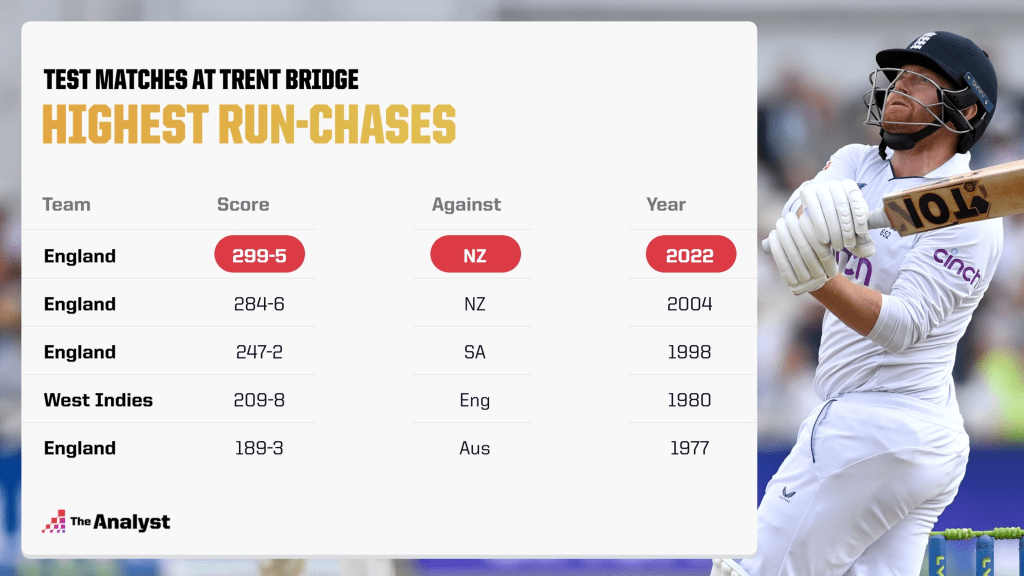
For New Zealand, it’s agony. After setting 553 in the first innings, it seemed unthinkable they’d be in a losing position come the fifth day, but here we are. Their 553 is the fourth-highest first innings score in history for a side that has gone on to lose the game and it will be no solace that the team who hold that unwanted record, Bangladesh (595-8d) in 2017, were beaten by New Zealand in that game.
As they always do, the Kiwis played their part in an unbelievable match, one which set the record for the most boundaries of any Test in history and witnessed more runs than in any other at Trent Bridge.
It was England’s attacking intent across this game that carried them over the line. They hit almost 11.9% of the balls they faced for a boundary, which is the highest boundary % of any Test match in England’s history on record, beating the 11.8% they set at the same venue in 2015 against Australia.
If the last two weeks are anything to go by, English cricket fans are set for an entertaining few years under Brendon McCullum and Ben Stokes.
June 13, Day Four
New Zealand 553 / England 539 / New Zealand 224-7
New Zealand lead by 238
Ok, ok. Before we go on. We need to address this.
What a shot.
But it’s a very clear sign of Joe Root’s importance in this game, someone with the impunity to play a shot like that and to have scored 176, that he was furious with himself for getting out. With him and Ben Foakes at the crease, it seemed inevitable that England would pass New Zealand’s first innings total. But as soon as he was out, slightly deceived by a slower ball from Trent Boult, that target suddenly looked very far away.
After that, everything happened very quickly. Michael Bracewell landed one in the footholes that Stuart Broad swiped at, edging to Mitchell at slip. Ben Foakes was then run out by team-mate Matthew Potts for an enterprising 50, his first in England. With a big, hooping yorker Trent Boult cleaned up Potts for his fifth wicket, and his 10th five-wicket haul in Test cricket. In a game where bat has completed dominated ball – this is only the seventh Test in England where both teams have made over 500 in the first innings – Boult was miserly, going for just over three an over. Only James Anderson was more economical in the first innings, while Boult’s dot ball percentage of 76% was by far the highest of all New Zealand bowlers in this effort.
All in all, New Zealand cleaned up the last five wickets for just 66 runs this morning with England trailing by 14.
England came out to bowl before lunch in cloudy conditions under the lights. Anderson struck in the first over, bowling Tom Latham who misjudged a leave, to claim his 650th Test match wicket.
Conway and Young batted nicely and without much drama, compiling a 100-wicket stand. Both got in and got themselves out. Conway was caught off a top-edged sweep. while Young was the first of New Zealand’s two runs out today. It’s becoming something of a recurrence for Young, that’s now six scores of 50+ without reaching a hundred.
Generally, New Zealand’s batters found life easiest against Jack Leach, who struggled for consistency in this innings. With the overall innings run rate at 3.2, Leach went at just under four runs an over. The tourists attacked him more frequently than any other England bowler and that was reflected in his boundary % being comfortable the highest of the home side.
Yet England have stayed in this game, chipping away with a wicket here and there. Admittedly they have benefitted by a raft of soft dismissals from New Zealand. Nicholls cutting lazily to point. Blundell being suckered in by England’s short bowling. Bracewell’s enterprising, yet kamikaze innings. Mitchell turning blind running for two and leaving Tim Southee stranded.
Just as he has been all game, Mitchell is key. If he can farm the strike tomorrow, he might be able to take the game out of England’s reach. Remove him and the rest of the tail early, and we might see some fireworks as England look to chase down a gettable target.
June 12, Day Three
New Zealand 553 / England 473-5
England trail by 80
Runs, runs and more runs were the order of the day at Trent Bridge.
England finished a thrilling day three 473-5, trailing by 80 runs. Thanks to mammoth centuries by Joe Root and Ollie Pope, they somehow look set to eclipse New Zealand’s giant total in the first innings.
Alex Lees and Pope set the tone early on, the pair compiling a 141-run partnership for the second wicket. It was Matt Henry who eventually made the breakthrough for the tourists, dismissing Lees who drove loosely at a wide delivery. 67 was Lees’ highest score in Tests to date, but given the way New Zealand had batted in the first innings and the state of the flat pitch, he will feel it was a big opportunity missed.
Such has been England’s struggles at the top of the order in recent years that this partnership was just the second 100+ stand for the second wicket since July 2020. They’ve played 25 Tests in that time.
In fact, from the start of 2020, of the 11 Test nations that have played Test cricket only West Indies have a lower average for the second wicket. England’s average in that time frame is a mere 28.9.
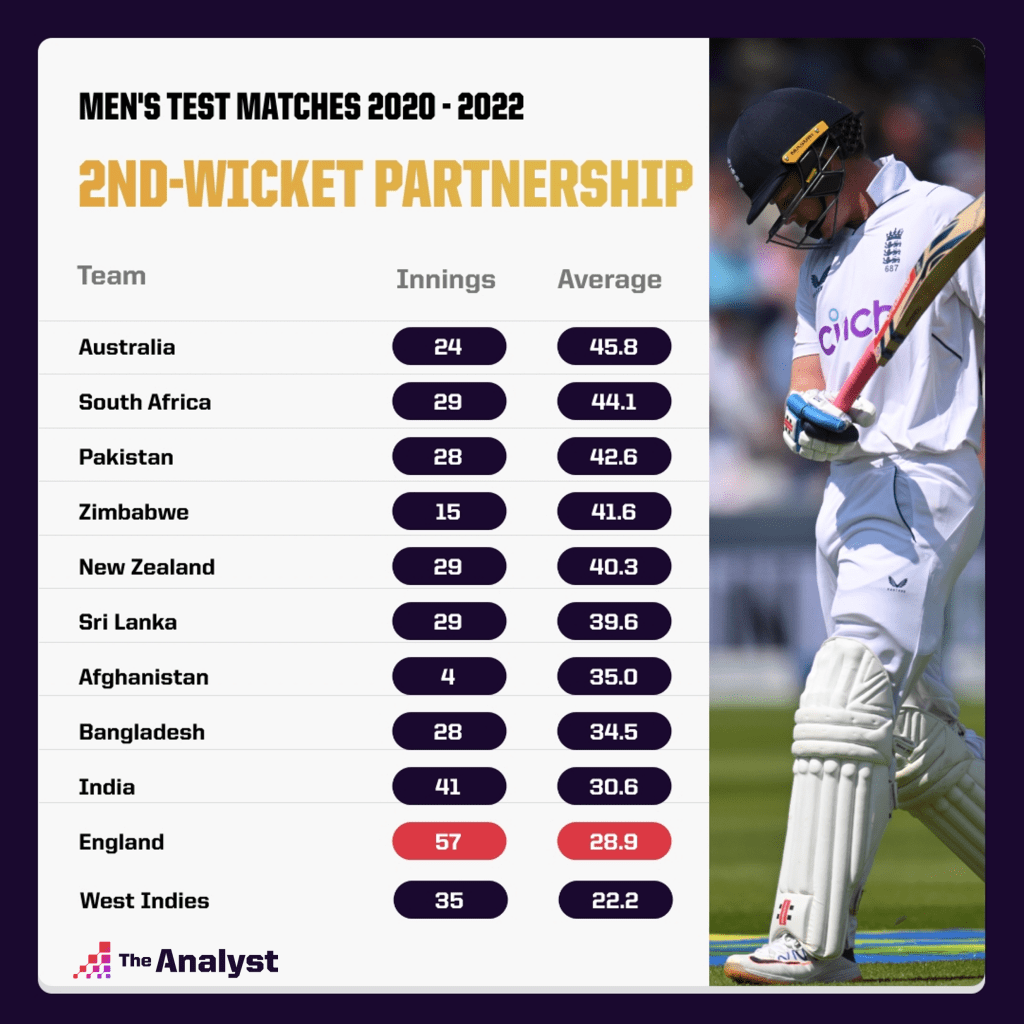
As is often the case when Joe Root comes to the crease, the runs kept flowing. Pope was the first to reach triple figures, his second century and first batting at No. 3. Pope thriving at three will be pleasing for Stokes, McCullum and the rest of the hierarchy at England. It was a brave call given he’s never batted there for Surrey and he’s responded really well after Lord’s.
From the moment Root came to the crease, clipping his first ball off his legs and scampering two, a big score was on the cards. He whizzed his way to 50 off 56 balls – his seventh fastest Test half-century – before continuing to inflict pain on the New Zealand bowlers. His 27th Test Century was an inevitability and coming off just 116 balls it was his fastest ever. Almost half (45%) of his deliveries were met with an attacking shot, such was his aggressive intent.
Root has converted 10 of his last 14 fifties into 100s (71%). All that talk about poor conversion rate has been well and truly put to bed.
After a 187-run partnership between the pair, Pope was caught on the hook for 145, his highest Test score.
Bairstow fell shortly afterwards, and despite the deluge of runs England were 344-4 and still trailing by 209 runs.
Ben Stokes clubbed his way to an entertaining innings of 46 from 33 balls, clearly embodying the attacking mindset of his coach.
For Root, the runs just kept coming. He reached 150 off 181 balls, and his raised bat was met with looks of incredulity from the England dressing room. It’s not meant to be this easy.
Since the start of 2021, he has scored 1,139 more runs than anyone else in Test match cricket and has 10 hundreds at an average of 60.4.
The hosts ended the day trailing by 80 runs and we are now hurtling towards a run-laded draw.
For Root, The Analyst’s Score Predictor reckons he’ll end up with 218 in this one, with what would be his sixth double-hundred.
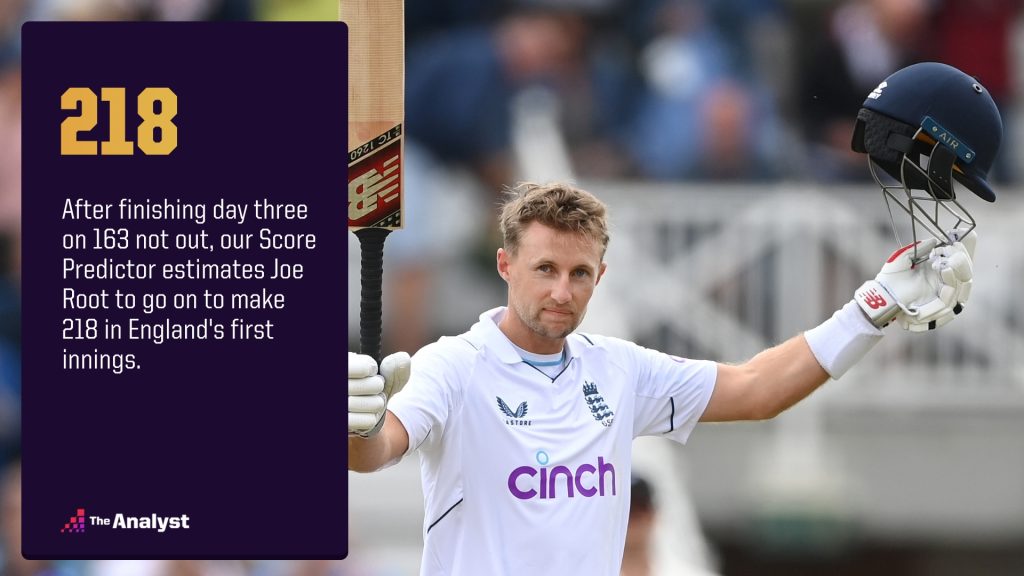
June 11, Day Two
New Zealand 553 / England 90-1
England trail by 463
Day two started as day one had ended, with New Zealand pair Daryl Mitchell and Tom Blundell accumulating big runs as England’s bowlers toiled. The duo, who shared a 195-run stand in the second innings of New Zealand’s five-wicket defeat at Lord’s last week had put on 149 by stumps on day one.
This morning they added 87 together, with both batsmen getting to three figures. By the time Blundell was caught by Stokes at mid-off for 106 – the first Test century by a New Zealand wicketkeeper in England – their fifth-wicket partnership was worth 236, the highest such stand for New Zealand in Test history.
For Mitchell, that’s now back-to-back centuries against England. The Kiwi is just the fifth New Zealand player to accomplish that feat.
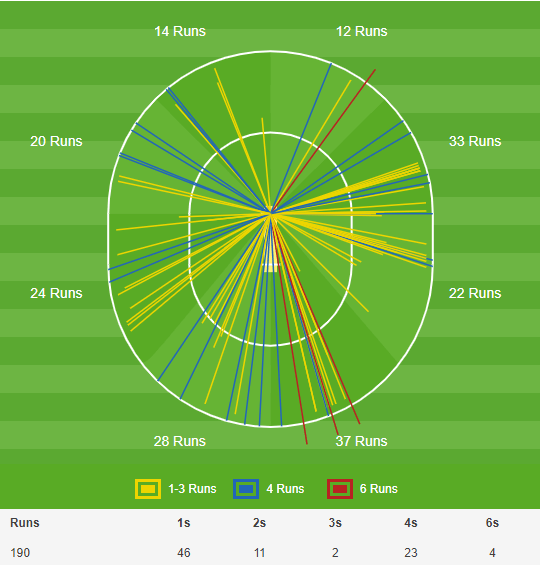
After Blundell’s dismissal, debutant Michael Bracewell arrived at the crease, and showed no nerves whatsoever, carving his way to a fluent 49.
Mitchell fell just short of a double century, but not before he’d entered into the top five for New Zealand individual scores in England:

England finally bowled the visitors out for 553, the third-highest total a side has scored against them after being inserted into bat. That’s a decision Ben Stokes would like back.
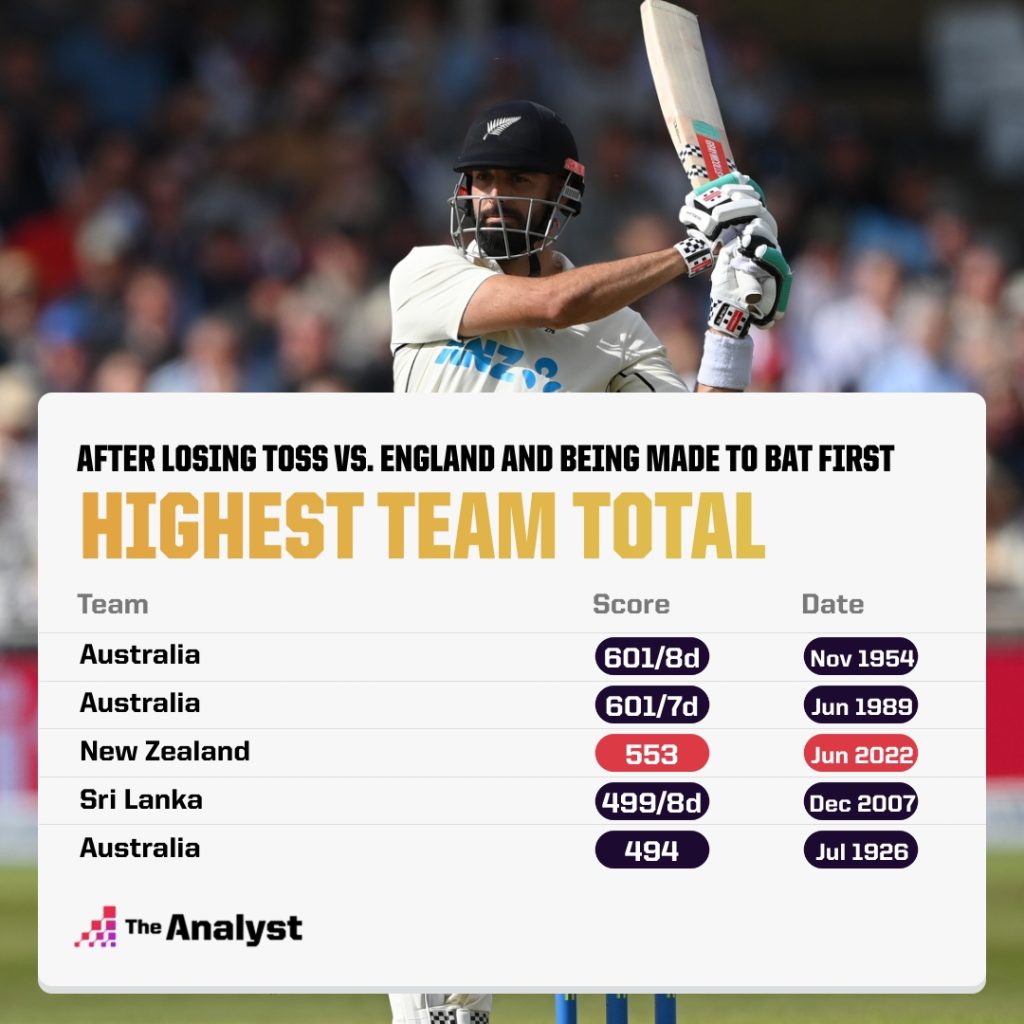
England were poor in the field yesterday and it wasn’t much better today. Matthew Potts completely misjudged a catch off an unfortunate Jack Leach, and Mitchell was given yet another lifeline. Potts’ drop cost the side 86 runs, while Root dropped Mitchell on three yesterday… the former England skipper will be eager to earn those runs back for the side.
Anderson was his miserly self, picking up 3-62 off 27 overs, but the other bowlers struggled to contain New Zealand’s aggressive approach. Matthew Potts was particularly luckless, conceding 126 runs from his 30.3 overs without a wicket to his name. It was a stark difference from his debut. A week is a long time in Test cricket, eh?
After fielding for just shy of two days, England’s openers then had the unenviable task of batting in the evening session. A Trent Boult beauty did for Zak Crawley, while both Alex Lees and Ollie Pope were dropped at slip by none other than Daryl Mitchell.
Can the pair do what Mitchell did and punish the opposition for gifting them a life? Our score predictor fancies each of the set batters to go past fifty tomorrow but particularly likes Pope’s chances of going big, with his predicted score at 99.
Given the fluency of some of the cover drives both played towards the end of the day suggest those scores are not unreasonable.
At stumps of day two, New Zealand remain massive favourites to win the game.
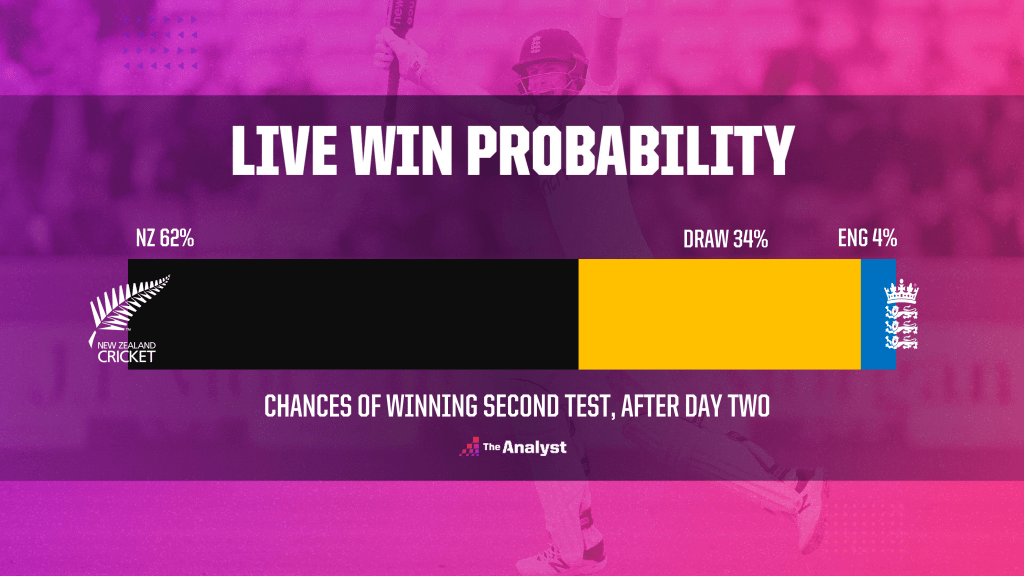
June 10, Day One
New Zealand 318-4
England’s new era under the Brendon McCullum-Ben Stokes axis got off to the perfect start at Lord’s last week. A five-wicket victory in the first Test of the series was their first win in eight matches, and a win in this second Test will give them consecutive victories in men’s Tests for the first time since February 2021.
Before a ball was bowled, our cricket simulation model had the home team as 48.2% favourites, with New Zealand at 41.2% and the draw at 10.6%.
But after an opening stand of 84 between Will Young and Tom Latham – the highest opening partnership in a Test match at Trent Bridge since 2005 – it looked like a good toss for New Zealand to lose. The pitch had a nice even pace and bounce to it, and conditions were not offering much by the way of swing.
Despite coming off the back of five consecutive single-digit scores, Young looked fluent and positive. Latham looked to attack poor deliveries. And by the time the pair had put on 84 runs together, the live probability had flipped on its head. New Zealand were now in the box seat at 59.6%, with England dropping down to 23.4%. The model also predicted the Black Caps to score 350.
But in the space of two balls England fought back. First, Stokes dismissed Young, with the right-handed opener fencing a delivery to the slips where a diving Zak Crawley took a superb low catch. Next, it was Latham, mistiming a pull shot off James Anderson and getting caught at mid-wicket by a sprawling Matthew Potts.
After those two quick wickets, the predicted match outcome swung again, with New Zealand still favourites (47.7%) but only marginally so (England 43.6%).
Henry Nicholls and Devon Conway came together to put on a brisk 77, before Stokes played partnership breaker again, enticing an edge from Nicholls into the gloves of Ben Foakes.
As in the morning session, one wicket brought another, with Anderson removing Conway just four runs shy of his 50.
Now, England’s catching was superb in the first Test match, snaffling all 13 of their chances. But their old deficiencies were still on show, with Crawley dropping a sharp chance from Nicholls and Joe Root dropping a regulation edge from Mitchell. It’s something that England have really struggled with over the last few years. Of the 11 teams that have played Test cricket since the beginning of 2021, England are seventh for catch success rate (76%), which is something that McCullum – a brilliant fielder himself – will be keen to improve.
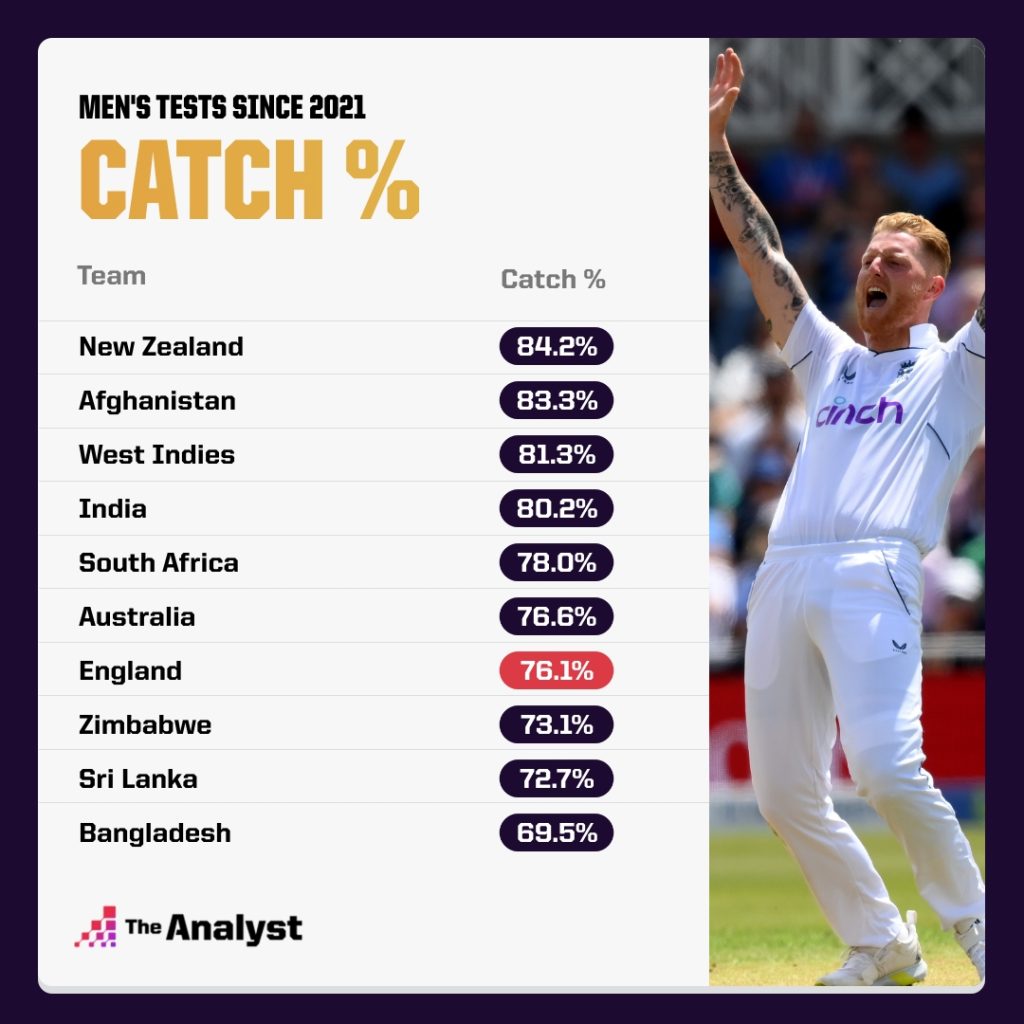
But Mitchell, centurion at Lord’s, continued to punish England for dropping him, taking a particular fancy to Jack Leach. The scoring rates have been very different to the Lord’s Test, granted, but in his first six overs, Leach was hit for more boundaries (5) than replacement Matt Parkinson was in the entire first Test.
There were further England opportunities that went begging, most notably after they had taken the second new ball when Bairstow and Crawley both left an edge from Tom Blundell for the other man to pluck from the air. To say Stuart Broad was unhappy to see his work go unrewarded is an understatement. The day ended with the Mitchell/Blundell partnership poised on 149, a classy rescue operation that has put New Zealand in the driving seat, early but strong favourites to level the series.
Enjoy this? Subscribe to our mailing list to receive exclusive weekly content.
